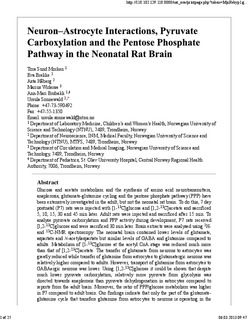Neuron-astrocyte interactions, pyruvate carboxylation and the pentose phosphate pathway in the neonatal rat brain
Morken, Tora Sund; Brekke, Eva Mari Førland; Håberg, Asta; Widerøe, Marius; Brubakk, Ann-Mari; Sonnewald, Ursula
Journal article, Peer reviewed
Permanent lenke
http://hdl.handle.net/11250/2391501Utgivelsesdato
2014Metadata
Vis full innførselSamlinger
Sammendrag
Glucose and acetate metabolism and the synthesis of amino acid neurotransmitters, anaplerosis, glutamate-glutamine cycling and the pentose phosphate pathway (PPP) have been extensively investigated in the adult, but not the neonatal rat brain. To do this, 7 day postnatal (P7) rats were injected with [1-(13)C]glucose and [1,2-(13)C]acetate and sacrificed 5, 10, 15, 30 and 45 min later. Adult rats were injected and sacrificed after 15 min. To analyse pyruvate carboxylation and PPP activity during development, P7 rats received [1,2-(13)C]glucose and were sacrificed 30 min later. Brain extracts were analysed using (1)H- and (13)C-NMR spectroscopy. Numerous differences in metabolism were found between the neonatal and adult brain. The neonatal brain contained lower levels of glutamate, aspartate and N-acetylaspartate but similar levels of GABA and glutamine per mg tissue. Metabolism of [1-(13)C]glucose at the acetyl CoA stage was reduced much more than that of [1,2-(13)C]acetate. The transfer of glutamate from neurons to astrocytes was much lower while transfer of glutamine from astrocytes to glutamatergic neurons was relatively higher. However, transport of glutamine from astrocytes to GABAergic neurons was lower. Using [1,2-(13)C]glucose it could be shown that despite much lower pyruvate carboxylation, relatively more pyruvate from glycolysis was directed towards anaplerosis than pyruvate dehydrogenation in astrocytes. Moreover, the ratio of PPP/glucose-metabolism was higher. These findings indicate that only the part of the glutamate-glutamine cycle that transfers glutamine from astrocytes to neurons is operating in the neonatal brain and that compared to adults, relatively more glucose is prioritised to PPP and pyruvate carboxylation. Our results may have implications for the capacity to protect the neonatal brain against excitotoxicity and oxidative stress.
